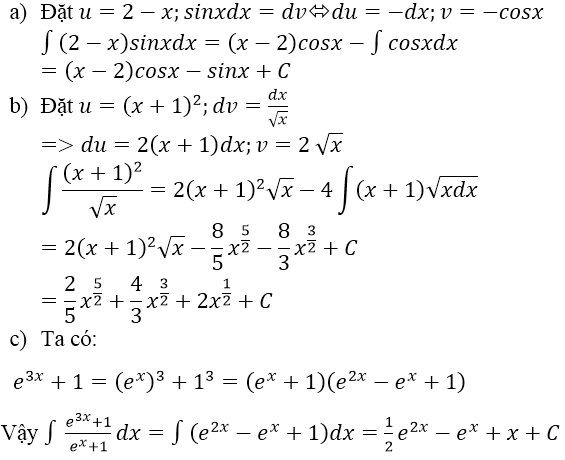
Hãy nhập câu hỏi của bạn vào đây, nếu là tài khoản VIP, bạn sẽ được ưu tiên trả lời.


a) \(\int\left(x+\ln x\right)x^2\text{d}x=\int x^3\text{d}x+\int x^2\ln x\text{dx}\)
\(=\dfrac{x^4}{4}+\int x^2\ln x\text{dx}+C\) (*)
Để tính: \(\int x^2\ln x\text{dx}\) ta sử dụng công thức tính tích phân từng phần như sau:
Đặt \(\left\{{}\begin{matrix}u=\ln x\\v'=x^2\end{matrix}\right.\) \(\Rightarrow\left\{{}\begin{matrix}u'=\dfrac{1}{x}\\v=\dfrac{1}{3}x^3\end{matrix}\right.\)
Suy ra:
\(\int x^2\ln x\text{dx}=\dfrac{1}{3}x^3\ln x-\dfrac{1}{3}\int x^2\text{dx}\)
\(=\dfrac{1}{3}x^3\ln x-\dfrac{1}{3}.\dfrac{1}{3}x^3\)
Thay vào (*) ta tính được nguyên hàm của hàm số đã cho bằng:
(*) \(=\dfrac{1}{3}x^3-\dfrac{1}{3}x^3\ln x+\dfrac{1}{9}x^3+C\)
\(=\dfrac{4}{9}x^3-\dfrac{1}{3}x^3\ln x+C\)
b) Đặt \(\left\{{}\begin{matrix}u=x+\sin^2x\\v'=\sin x\end{matrix}\right.\)
\(\Rightarrow\left\{{}\begin{matrix}u'=1+2\sin x.\cos x\\v=-\cos x\end{matrix}\right.\)
Ta có:
\(\int\left(x+\sin^2x\right)\sin x\text{dx}=-\left(x+\sin^2x\right)\cos x+\int\left(1+2\sin x\cos^2x\right)\text{dx}\)
\(=-\left(x+\sin^2x\right)\cos x+\int\cos x\text{dx}+2\int\sin x.\cos^2x\text{dx}\)
\(=-\left(x+\sin^2x\right)\cos x+\sin x-2\int\cos^2x.d\left(\cos x\right)\)
\(=-\left(x+\sin^2x\right)\cos x+\sin x-2\dfrac{\cos^3x}{3}+C\)

a)
Đặt \(u=\sqrt{x-3}\Rightarrow x=u^2+3\)
\(I_1=\int (2x-3)\sqrt{x-3}dx=\int (2u^2+3)ud(u^2+3)=2\int (2u^2+3)u^2du\)
\(\Leftrightarrow I_1=4\int u^4du+6\int u^2du=\frac{4u^5}{5}+2u^3+c\)
b)
\(I_2=\int \frac{xdx}{\sqrt{(x^2+1)^3}}=\frac{1}{2}\int \frac{d(x^2+1)}{\sqrt{(x^2+1)^2}}\)
Đặt \(u=\sqrt{x^2+1}\). Khi đó:
\(I_2=\frac{1}{2}\int \frac{d(u^2)}{u^3}=\int \frac{udu}{u^3}=\int \frac{du}{u^2}=\frac{-1}{u}+c\)
c)
\(I_3=\int \frac{e^xdx}{e^x+e^{-x}}=\int \frac{e^{2x}dx}{e^{2x}+1}=\frac{1}{2}\int\frac{d(e^{2x}+1)}{e^{2x}+1}\)
\(\Leftrightarrow I_3=\frac{1}{3}\ln |e^{2x}+1|+c=\frac{1}{2}\ln|u|+c\)
d)
\(I_4=\int \frac{dx}{\sin x-\sin a}=\int \frac{dx}{2\cos \left ( \frac{x+a}{2} \right )\sin \left ( \frac{x-a}{2} \right )}\)
\(\Leftrightarrow I_4=\frac{1}{\cos a}\int \frac{\cos \left ( \frac{x+a}{2}-\frac{x-a}{2} \right )dx}{2\cos \left ( \frac{x+a}{2} \right )\sin \left ( \frac{x-a}{2} \right )}=\frac{1}{\cos a}\int \frac{\cos \left ( \frac{x-a}{2} \right )dx}{2\sin \left ( \frac{x-a}{2} \right )}+\frac{1}{\cos a}\int \frac{\sin \left ( \frac{x+a}{2} \right )dx}{2\cos \left ( \frac{x+a}{2} \right )}\)
\(\Leftrightarrow I_4=\frac{1}{\cos a}\left ( \ln |\sin \frac{x-a}{2}|-\ln |\cos \frac{x+a}{2}| \right )+c\)
e)
Đặt \(t=\sqrt{x}\Rightarrow x=t^2\)
\(I_5=\int t\sin td(t^2)=2\int t^2\sin tdt\)
Đặt \(\left\{\begin{matrix} u=t^2\\ dv=\sin tdt\end{matrix}\right.\Rightarrow \left\{\begin{matrix} du=2tdt\\ v=-\cos t\end{matrix}\right.\)
\(\Rightarrow I_5=-2t^2\cos t+4\int t\cos tdt\)
Tiếp tục nguyên hàm từng phần \(\Rightarrow \int t\cos tdt=t\sin t+\cos t+c\)
\(\Rightarrow I_5=-2t^2\cos t+4t\sin t+4\cos t+c\)

a) =
=
b) =
=
=
c)=
d)=
=
e)=
=
g)Ta có f(x) = sin3xcos5x là hàm số lẻ.
Vì f(-x) = sin(-3x)cos(-5x) = -sin3xcos5x = f(-x) nên:

Câu nào mình biết thì mình làm nha.
1) Đổi thành \(\dfrac{y^4}{4}+y^3-2y\) rồi thế số.KQ là \(\dfrac{-3}{4}\)
2) Biến đổi thành \(\dfrac{t^2}{2}+2\sqrt{t}+\dfrac{1}{t}\) và thế số.KQ là \(\dfrac{35}{4}\)
3) Biến đổi thành 2sinx + cos(2x)/2 và thế số.KQ là 1

a)
Ta có:
∫π20cos2xsin2xdx=12∫π20cos2x(1−cos2x)dx=12∫π20[cos2x−1+cos4x2]dx=14∫π20(2cos2x−cos4x−1)dx=14[sin2x−sin4x4−x]π20=−14.π2=−π8∫0π2cos2xsin2xdx=12∫0π2cos2x(1−cos2x)dx=12∫0π2[cos2x−1+cos4x2]dx=14∫0π2(2cos2x−cos4x−1)dx=14[sin2x−sin4x4−x]0π2=−14.π2=−π8
b)
Ta có: Xét 2x – 2-x ≥ 0 ⇔ x ≥ 0.
Ta tách thành tổng của hai tích phân:
∫1−1|2x−2−x|dx=−∫0−1(2x−2−x)dx+∫10(2x−2−x)dx=−(2xln2+2−xln2)∣∣0−1+(2xln2+2−xln2)∣∣10=1ln2∫−11|2x−2−x|dx=−∫−10(2x−2−x)dx+∫01(2x−2−x)dx=−(2xln2+2−xln2)|−10+(2xln2+2−xln2)|01=1ln2
c)
∫21(x+1)(x+2)(x+3)x2dx=∫21x3+6x2+11x+6x2dx=∫21(x+6+11x+6x2)dx=[x22+6x+11ln|x|−6x]∣∣21=(2+12+11ln2−3)−(12+6−6)=212+11ln2∫12(x+1)(x+2)(x+3)x2dx=∫12x3+6x2+11x+6x2dx=∫12(x+6+11x+6x2)dx=[x22+6x+11ln|x|−6x]|12=(2+12+11ln2−3)−(12+6−6)=212+11ln2
d)
∫201x2−2x−3dx=∫201(x+1)(x−3)dx=14∫20(1x−3−1x+1)dx=14[ln|x−3|−ln|x+1|]∣∣20=14[1−ln2−ln3]=14(1−ln6)∫021x2−2x−3dx=∫021(x+1)(x−3)dx=14∫02(1x−3−1x+1)dx=14[ln|x−3|−ln|x+1|]|02=14[1−ln2−ln3]=14(1−ln6)
e)
∫π20(sinx+cosx)2dx=∫π20(1+sin2x)dx=[x−cos2x2]∣∣π20=π2+1∫0π2(sinx+cosx)2dx=∫0π2(1+sin2x)dx=[x−cos2x2]|0π2=π2+1
g)
I=∫π0(x+sinx)2dx∫π0(x2+2xsinx+sin2x)dx=[x33]∣∣π0+2∫π0xsinxdx+12∫π0(1−cos2x)dxI=∫0π(x+sinx)2dx∫0π(x2+2xsinx+sin2x)dx=[x33]|0π+2∫0πxsinxdx+12∫0π(1−cos2x)dx
Tính :J=∫π0xsinxdxJ=∫0πxsinxdx
Đặt u = x ⇒ u’ = 1 và v’ = sinx ⇒ v = -cos x
Suy ra:
J=[−xcosx]∣∣π0+∫π0cosxdx=π+[sinx]∣∣π0=πJ=[−xcosx]|0π+∫0πcosxdx=π+[sinx]|0π=π
Do đó:
I=π33+2π+12[x−sin2x2]∣∣π30=π33+2π+π2=2π3+15π6
